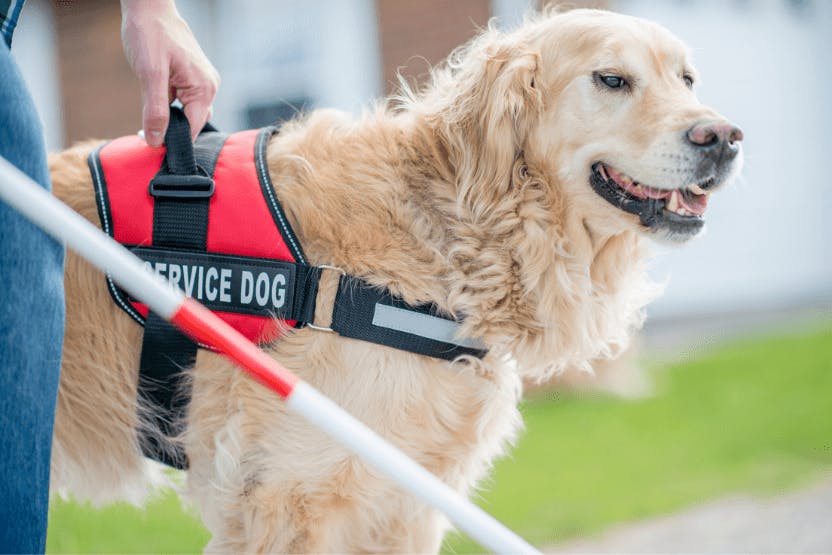For anyone who’s had a dog, you know just how invaluable their love and companionship can be. But for some people, their dog can literally save their life. Service dogs do more than just provide licks and snuggles for people with disabilities. These trained dogs can help them to perceive or live in the world around them, and can even help them through life-threatening situations.
A service dog has many names, depending on what they do for their parent, such as medical response dog, medical relief dog, detection dog, assistance dog, or alert dog. But whatever they may be called, they become an invaluable part of a team with their owner, watching and responding to their partner’s medical condition. While most people are familiar with seeing eye dogs for the blind, dogs can be trained to help with everything from detecting seizures to helping an autistic child stay safe.
Can a service dog help you? Let’s explore what service dogs can do, what kinds of dogs make the best service pooches, and how a pup goes from a playful pal to a working dog.

What can a medical service dog do?
It’s simply pawmazing what dogs can do! With their heightened senses of hearing and smell, paired with their love and attention to their owner, dogs prove that they really are our best friends. Untrained dogs often become guardians and companions, knowing when we are sad, hurt or just need them, but trained dogs can use those same skills to help us cope with medical issues that are out of our control.
Types of service dogs include:
- Guide Dogs for the Blind – Helps visually impaired people navigate around obstacles, stairs, street crossings and crowds.
- Hearing Dogs – Helps deaf or hard of hearing people by alerting them to alarms, doorbells, phones that are ringing, or when their name is called.
- Diabetic Alert Dog – Can smell changes in their owner’s blood sugar levels, alerting them when they need to take insulin or ingest sugary foods.
- Seizure Response Dog – Can detect an upcoming seizure, retrieve medication, move their owner out of harm’s way during a seizure, and call 911.
- Allergy Detection Dog – Assist severely allergic people by sniffing out even the tiniest traces of their allergen so they can avoid it.
- Mobility Assistance Dog –Assists people in wheelchairs, or those with conditions such as muscular dystrophy or arthritis by bracing to help them move, retrieving objects, opening doors, or switching on lights.
- PTSD Assistance Dog – Can disrupt PTSD episodes, create a physical barrier between their owner and others, and help instill confidence in unnerving situations.
- Autism Service Dog – Can alert parents of an autistic child to any dangerous situations, interrupt disruptive behavior, improve connections with peers, and help with confidence.

Can any dog be a service dog?
If you’ve got a medical condition, and a furbulous pup in your home, you might wonder if your dog could become a service dog. Unfurtunately, pet dogs don’t make good service dogs simply because they haven’t been properly trained from a young age to do the tasks that are needed. But there are certain dogs that have the right stuff to make them excellent service dogs due to their temperament or breed.
The pawfect service dog needs to be:
- Motivated – A service should love to work more than lay around and be easy to train.
- Intelligent – Service dogs need to be able to learn and complete complex tasks and make good decisions.
- Friendly – A good service dog needs to be comfortable around different people and animals.
- Loving – For a dog/owner partnership to work, love can help form a strong bond.
- Calm – The best service dog won’t be easily startled or distracted, and can remain calm and focused in any situation.
- Strong – For dogs who will assist with mobility issues or seizure work, they’ll need to be able to handle the physical demands of the job.

Which dog breeds make the best service dogs?
Some breeds are definitely better at being service dogs than others, as they genetically have the physical and mental capacity to excel at service tasks. These breeds include:

How can a dog become a service dog?
Once a pup displays the characteristics needed for service work, they are generally socialized and trained in
basic obedience. Then, they are trained in the specific tasks needed for their particular job, such as pulling wheelchairs, judging how to cross a busy street, or even learning how to recognize subtle signs of a PTSD or an autistic episode. Service dogs are also trained to
ignore noises or distractions, to focus in public, to remain calm by their owner’s side, and to make good decisions.
Dog training can take up to two years before a dog is ready to be paired with a person who needs them, and only 30 - 50% of dogs make it through their specific program. Once they’ve completed their training, they are matched with their person, and the important work of helping their partner live a safer and more fulfilled life really begins.
If you feel you are in need of a medical service dog, there are many organizations in your area that are training your pawfect pal right now. With a quick search, you’ll be on your way to be paired with a dog who fits your needs and can form a bond that may just save your life.


